Development of Fluorescent Bacteria with Lux and Riboflavin Genes
Abstract
1. Introduction
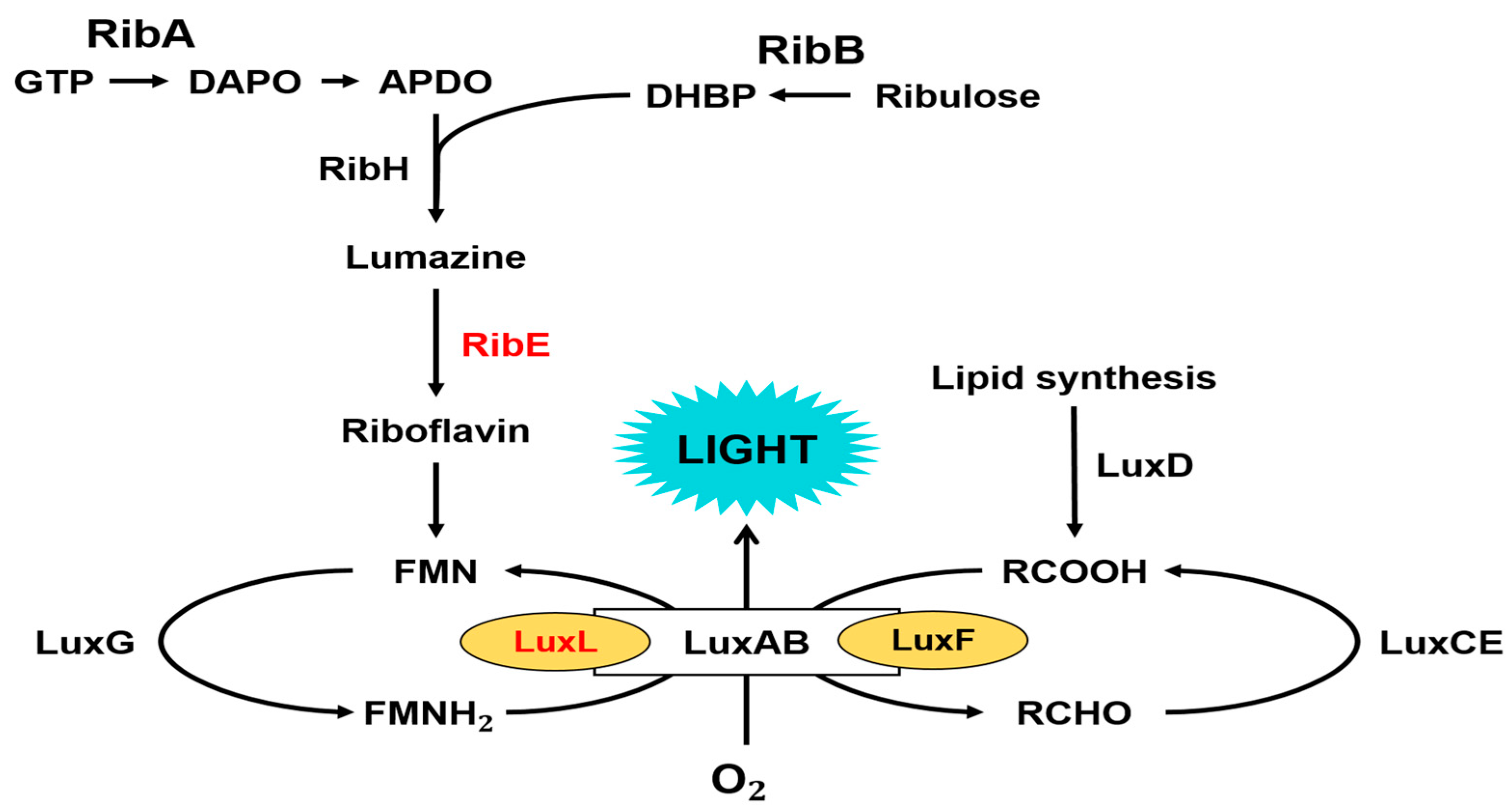

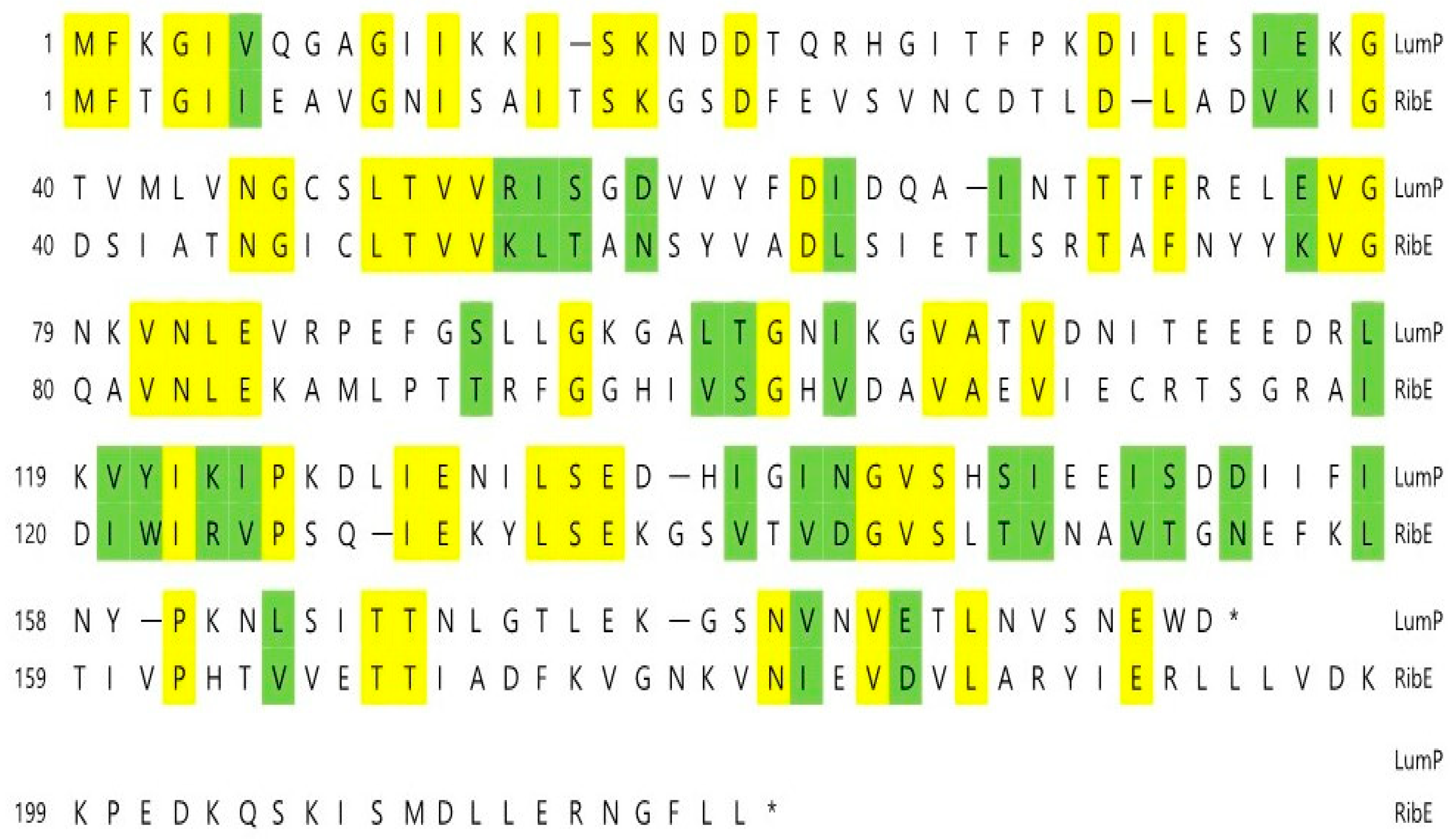
2. Results
2.1. Construction of pRFN Plasmid Derivatives
2.2. Fluorescence Intensities in E. coli
2.2.1. Fluorescence Intensities by Lumazine
2.2.2. Fluorescence Intensities by Riboflavin
2.3. Single-Cell Fluorescence Imaging by Confocal Microscopy
3. Discussion
4. Materials and Methods
4.1. Strains and Vectors
4.2. Preparation of Recombinant Plasmids by PCR
4.3. Buffer Solutions
4.4. Fluorescence Analysis
4.5. Imaging of Fluorescent E. coli under Confocal Microscopy
5. Conclusions
Author Contributions
Funding
Institutional Review Board Statement
Informed Consent Statement
Data Availability Statement
Conflicts of Interest
References
- Brodl, E.; Winkler, A.; Macheroux, P. Molecular Mechanisms of Bacterial Bioluminescence. Comput. Struct. Biotechnol. J. 2018, 16, 551–564. [Google Scholar] [CrossRef] [PubMed]
- Lee, J.; Müller, F.; Visser, A.J. The Sensitized Bioluminescence Mechanism of Bacterial Luciferase. Photochem. Photobiol. 2019, 95, 679–704. [Google Scholar] [CrossRef] [PubMed]
- Love, A.C.; Precher, J.A. Seeing (and Using) the Light: Recent Developments in Bioluminescence Technology. Cell Chem. Biol. 2020, 27, 904–920. [Google Scholar] [CrossRef]
- Meighen, E.A. Genetics of Bacterial of Bioluminescence. Annu. Rev. Genet. 1994, 28, 117–139. [Google Scholar] [CrossRef]
- Lee, C.Y.; O’Kane, D.J.; Meighen, E.A. Riboflavin Synthesis Genes are Linked with the lux Operon of Photobacterium phosphoreum. J. Bacteriol. 1994, 176, 2100–2104. [Google Scholar] [CrossRef]
- Gast, R.; Lee, J. Isolation of in vivo Emitter in Bacterial Bioluminescence. Proc. Natl. Acad Sci. USA 1978, 75, 833–837. [Google Scholar] [CrossRef]
- O’Kane, D.J.; Karle, A.J.; Lee, J. Chemical Characterization of Lumazine Protein from Photobacterium leiognathi: Comparison with lumazine protein from Photobacterium phosphoreum. Biochemistry 1985, 24, 1467–1475. [Google Scholar] [CrossRef]
- O’Kane, D.J.; Woodward, B.; Lee, J.; Prasher, D.C. Borrowed Proteins in Bacterial Bioluminescence. Proc. Natl. Acad. Sci. USA 1991, 88, 1100–1104. [Google Scholar] [CrossRef] [PubMed]
- Lee, J. Bioluminescence. In The Science of Photobiology; Smith, K.C., Ed.; Springer: New York, NY, USA, 1989; pp. 391–417. [Google Scholar]
- Lim, S.; Oh, E.; Choi, M.; Lee, E.; Lee, C.Y. Generation of Fluorescent Bacteria with the Genes Coding for Lumazine Protein and Riboflavin Biosynthesis. Sensors 2021, 21, 4506. [Google Scholar] [CrossRef] [PubMed]
- Chatwell, L.; Illarionova, V.; Illarionov, B.; Eisenreich, W.; Huber, R.; Skerra, A.; Bacher, A.; Fischer, M. Structure of Lumazine Protein, an Optical Transponder of Luminescent Bacteria. J. Mol. Biol. 2008, 382, 44–55. [Google Scholar] [CrossRef]
- Illarionov, B.; Eisenreich, W.; Wirth, M.; Lee, C.Y.; Woo, Y.E.; Bacher, A.; Fischer, M. Lumazine proteins from Photobacteria: Localization of the Single Ligand Binding Site to the N-terminal domain. Biol. Chem. 2007, 388, 1313–1323. [Google Scholar] [CrossRef] [PubMed]
- Illarionov, B.; Fischer, M.; Lee, C.Y.; Bacher, A.; Eisenreich, W. Rapid Preparation of Isotopolog Libraries by in vivo Transformation of 13C-Glucose. Studies on 6,7-Dimetyl-8-ribityllumazine, a Biosynthetic Precursor of Vitamin B2. J. Org. Chem. 2004, 69, 5588–5594. [Google Scholar] [CrossRef]
- Woo, Y.E.; Kim, S.Y.; Lee, C.Y. Generation and Expression of Amino-Terminal Domain of the Gene Coding for the Lumazine Protein from Photobacterium phosphoreum. Kor. J. Microbiol. 2005, 41, 306–311. [Google Scholar]
- Lee, C.Y.; Szittner, R.; Meighen, E.A. The lux Genes of the Luminous Bacterial Symbiont, Photobacterium leiognathi, of the ponyfish. Eur. J. Biochem. 1991, 201, 161–167. [Google Scholar] [CrossRef] [PubMed]
- Miyamoto, C.M.; Byers, D.; Graham, A.F.; Meighen, E.A. Expression of Bioluminescence in Escherichia coli by Recombinant Vibrio harveyi DNA. J. Bacteriol. 1987, 169, 247–253. [Google Scholar] [CrossRef]
- Paulus, B.; Illarionov, B.; Nohr, D.; Roellinger, G.; Kacprzak, S.; Fischer, M.; Weber, S.; Bacher, A.; Schleicher, E. One Protein, Two Chromophores: Comparative Spectroscopic Characterization of 6,7-Dimethyl-8-ribityllumazine and Riboflavin Bound to Lumazine Protein. J. Phys. Chem. 2014, 118, 13092–13105. [Google Scholar] [CrossRef]
- Klose, A.D.; Paragas, N. Automated Quantification of Bioluminescence Images. Nat. Commun. 2018, 9, 4262. [Google Scholar] [CrossRef]
- Rowe, L.; Dikici, E.; Daunert, S. Engineering Bioluminescent Proteins: Expanding their Analytical Potential. Anal. Chem. 2009, 81, 8662–8668. [Google Scholar] [CrossRef]
- Gregor, C.; Pape, J.K.; Gwosch, K.C.; Gilat, T.; Sahl, S.J.; Hell, S.W. Autonomous Bioluminescence Imaging of Single Mammalian Cells with the Bacterial Bioluminescence System. Proc. Natl. Acad. Sci. USA 2019, 116, 26491–26496. [Google Scholar] [CrossRef]
- Cui, B.; Zhang, I.; Song, Y.; Wei, J.; Li, C.; Wang, T.; Wang, Y.; Zhao, T.; Shen, X. Engineering an Enhanced, Thermostable, Monomeric Bacterial Luciferase Gene as a Reporter in Plant Protoplast. PLoS ONE 2014, 9, e107885. [Google Scholar] [CrossRef]
- Lei, Y.; Chen, W.; Mulchandani, A. Microbial Biosensors. Anal. Chim. Acta 2006, 568, 200–210. [Google Scholar] [CrossRef] [PubMed]
- Gregor, C.; Gwosch, K.; Sahl, S.J.; Hell, S.W. Strongly Enhanced Bacterial Bioluminescence with the Ilux Operon for Single-Cell Imaging. Proc. Natl. Acad. Sci. USA 2018, 115, 962–967. [Google Scholar] [CrossRef] [PubMed]
- Kessenikh, A.G.; Novoyatlova, U.S.; Bazhenov, S.V.; Stepanova, E.S.; Khrulnova, S.A.; Gnuchikh, E.Y.; Kotova, V.Y.; Kudryavtseva; Bermeshev, M.V.; Manukhov, I.N. Constructing of Bacillus subtillis-Based Lux Biosensors with the Use of Stress-Inducible Promoters. Int. J. Mol. Sci. 2021, 22, 9571. [Google Scholar] [CrossRef] [PubMed]

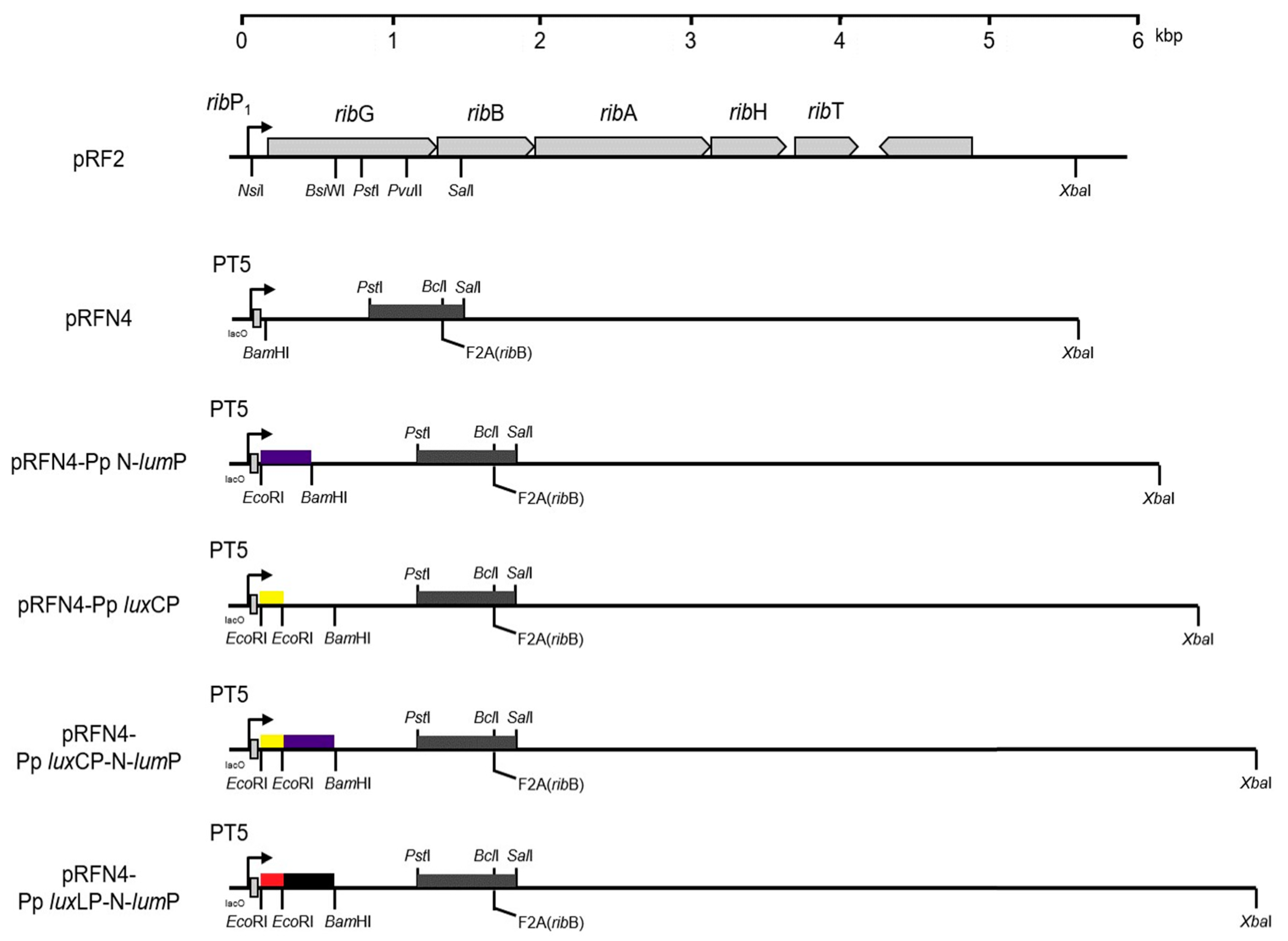
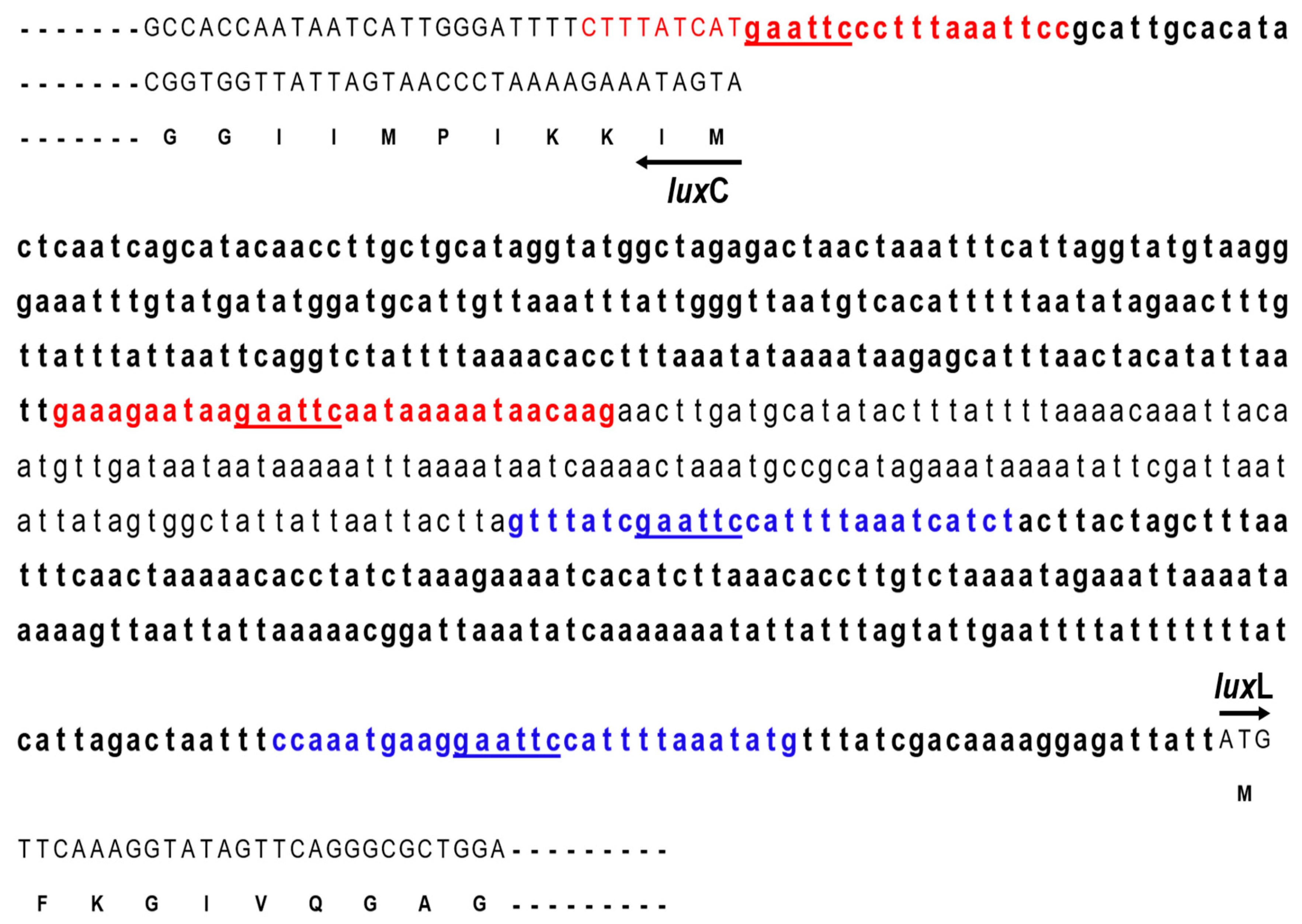

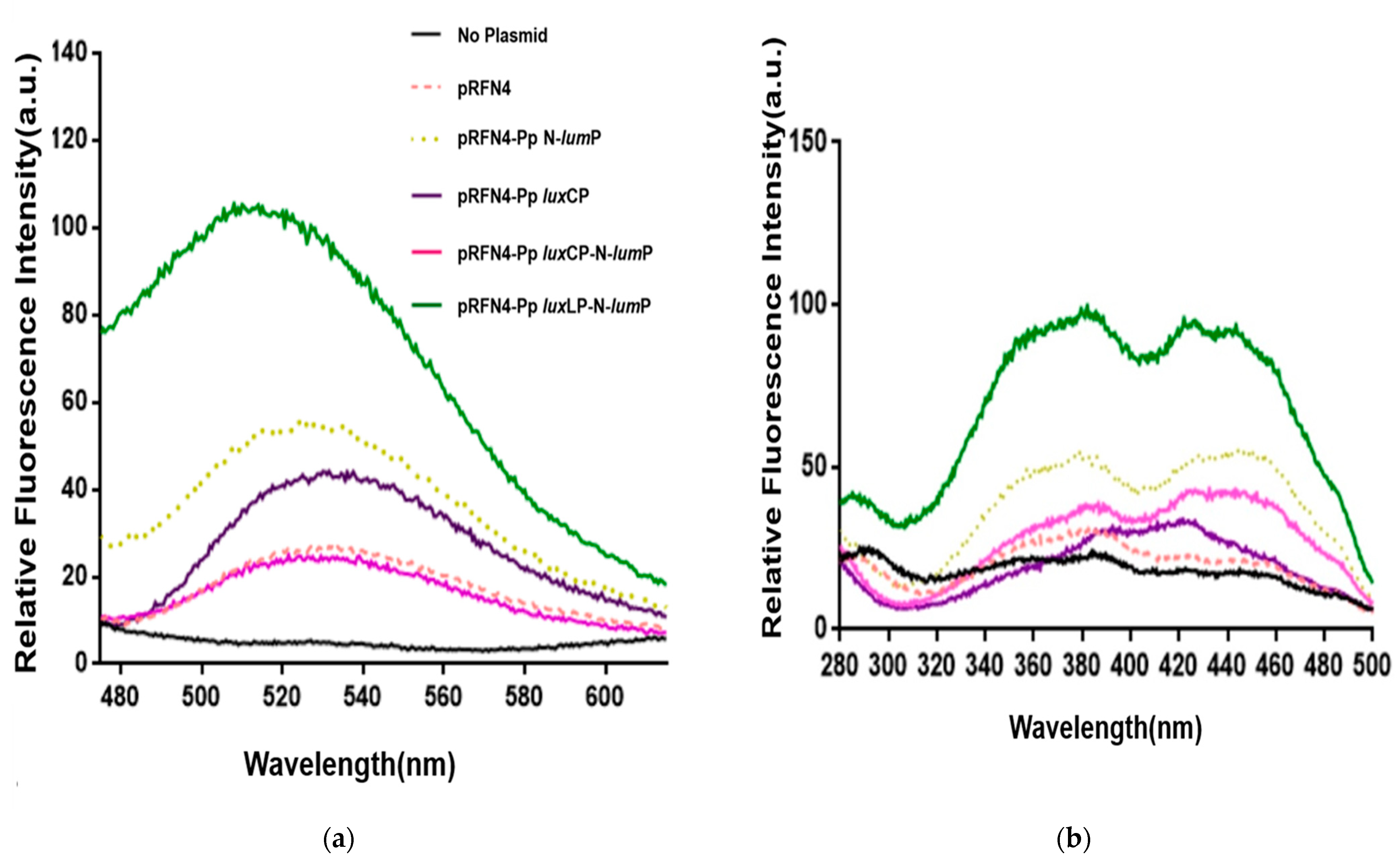
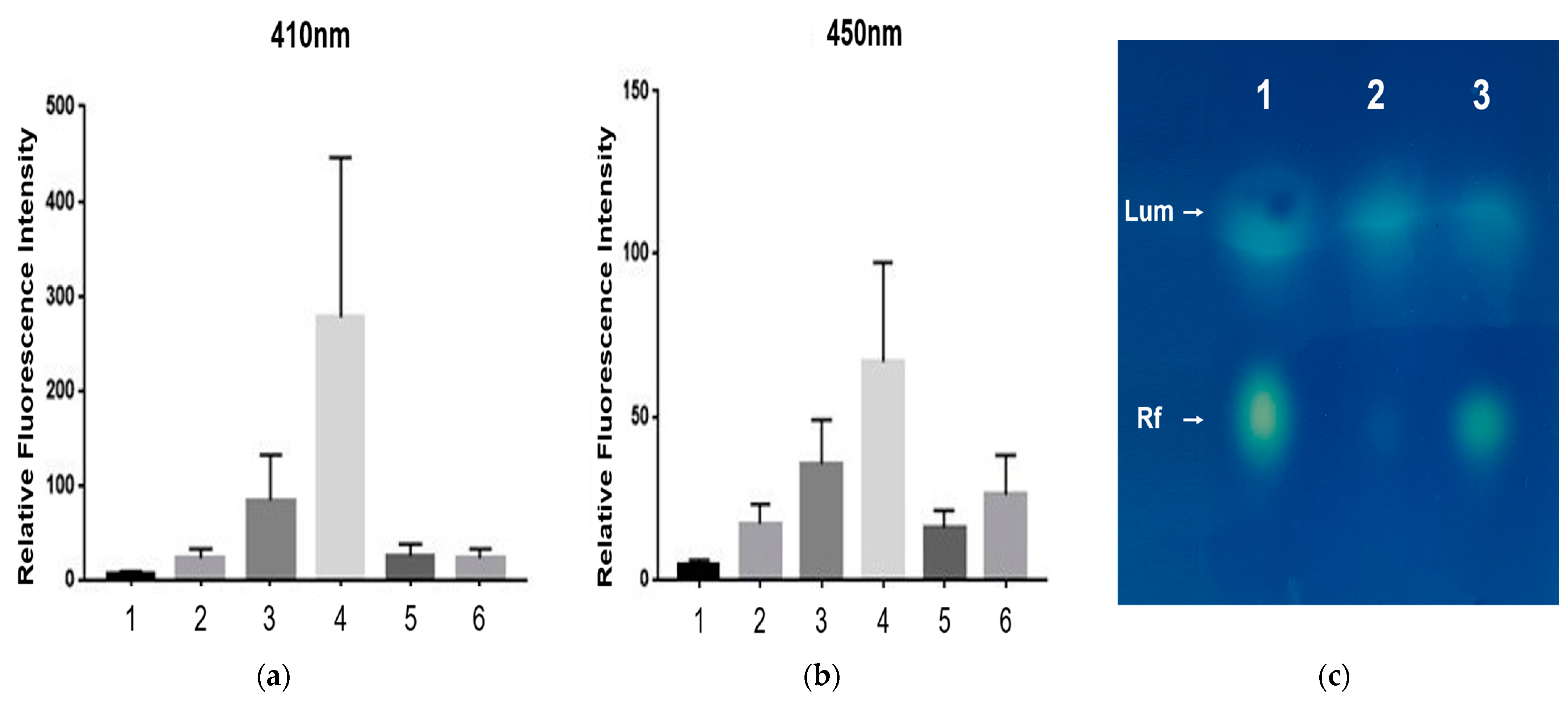
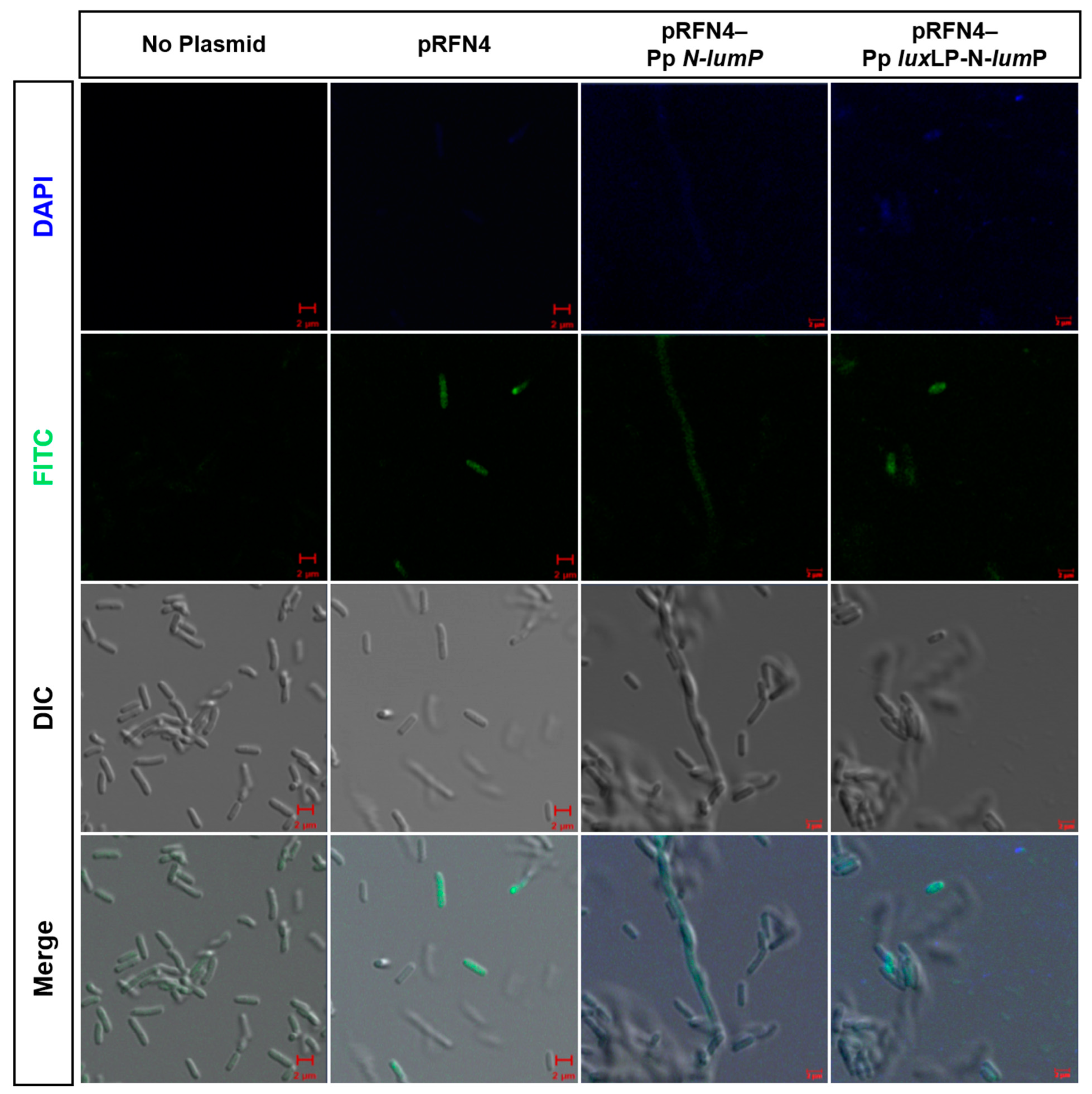
| Strains | Characteristics | Source |
| E. coli XL-1 Blue | Cloning strain | Real Biotech Corporation |
| E. coli 43R | Mutant of E. coli RR1 strain | Miyamoto.et al. (1987) J. Bacteriol. [16] |
| Plasmids | Characteristics | Source |
| pRFN4 | Recombinant plasmid containing the riboflavin genes from Bacillus subtilis | Illarionov et al. (2004) J. Org. Chem. [13] |
| pT7-5 PpEE | Recombinant pT7-5 plasmid containing the luxL and luxC genes, as well as their intergenic DNA from P. phosphoreum NCBM 844 | Woo et al. (2005) Kor. J. Microbiol. [14] |
| pRFN4- Pp N-lumP | pRFN4 plasmid inserting the gene of 5′-terminal half of luxL for N-LumP from P. phosphoreum | This study |
| pRFN4- Pp luxCP | pRFN4 plasmid inserting the promoter region for luxC from P. phosphoreum | This study |
| pRFN4- Pp luxCP-N-lumP | pRFN4-Pp N-lumP plasmid inserting the promoter region for luxC from P. phosphoreum | This study |
| pRFN4- Pp luxLP-N-lumP | pRFN4-Pp N-lumP plasmid inserting the DNA for promoter region for luxL from P. phosphoreum | This study |
| Species | Primer | Sequence |
|---|---|---|
| P. phosphoreum | N-lumP forward | 5′-CAAATGAAGAAGAATTCCATTTTAAATATG-3′ |
| P. phosphoreum | N-lumP reverse | 5′-AAACTTTAAGAGGATCCTCTTCTTC-3′ |
| P. phosphoreum | luxC promoter forward | 5′-CTTTATCATAGAATTCCCTTTAAATTCC-3′ |
| P. phosphoreum | luxC promoter reverse | 5′-CTTGTTATTTTTAGAATTCTCTTATTCTTTC-3′ |
| P. phosphoreum | luxL promoter forward | 5′-GTTTATCGAATTCCATTTTAAATCATC-3′ |
| P. phosphoreum | luxL promoter reverse | 5′-CATATTTAAAATGGAATTCTTCATTTGG-3′ |
Disclaimer/Publisher’s Note: The statements, opinions and data contained in all publications are solely those of the individual author(s) and contributor(s) and not of MDPI and/or the editor(s). MDPI and/or the editor(s) disclaim responsibility for any injury to people or property resulting from any ideas, methods, instructions or products referred to in the content. |
© 2023 by the authors. Licensee MDPI, Basel, Switzerland. This article is an open access article distributed under the terms and conditions of the Creative Commons Attribution (CC BY) license (https://creativecommons.org/licenses/by/4.0/).
Share and Cite
Lim, S.-J.; Choi, M.; Yun, I.; Lee, S.; Chang, N.; Lee, C.-Y. Development of Fluorescent Bacteria with Lux and Riboflavin Genes. Int. J. Mol. Sci. 2023, 24, 5096. https://doi.org/10.3390/ijms24065096
Lim S-J, Choi M, Yun I, Lee S, Chang N, Lee C-Y. Development of Fluorescent Bacteria with Lux and Riboflavin Genes. International Journal of Molecular Sciences. 2023; 24(6):5096. https://doi.org/10.3390/ijms24065096
Chicago/Turabian StyleLim, Sun-Joo, Miae Choi, Inseop Yun, Seulgi Lee, Ny Chang, and Chan-Yong Lee. 2023. "Development of Fluorescent Bacteria with Lux and Riboflavin Genes" International Journal of Molecular Sciences 24, no. 6: 5096. https://doi.org/10.3390/ijms24065096
APA StyleLim, S.-J., Choi, M., Yun, I., Lee, S., Chang, N., & Lee, C.-Y. (2023). Development of Fluorescent Bacteria with Lux and Riboflavin Genes. International Journal of Molecular Sciences, 24(6), 5096. https://doi.org/10.3390/ijms24065096





